The Best Workout Routine Ever, According to Science

From shoulder workouts guaranteed to give you that sought-after capped look to at-home leg exercises promising ironclad quads to HIIT workouts ensuring you’ll drop fat fast, it seems like every week there’s a new study touting the best way to work out. Let’s face it, no one workout regimen will work for every body. While an athlete training for a triathlon will have a regimen that circulates through runs, rides, and swims, a powerlifter will need to regularly perform compound movements like squats, bench presses, and deadlifts to gain the muscle they need to compete.
And while there’s no one-size-fits-all workout routine, one type of exercise promises a way to get your heart rate up, burn calories fast, and strengthen your muscles all at the same time. Circuit training, where you use heavy but manageable loads and work multiple muscle groups in the same routine by rotating through the exercises with little rest in between sets, can prompt the optimal metabolic response known as excess post-exercise oxygen consumption (EPOC).
That “afterburn” effect of continued calorie consumption for up to 48 hours after a session can offer you the biggest bang for your effort and time.
Best Workout Routine, According to Science
We asked exercise scientist Jeffrey M. Willardson, Ph.D., C.S.C.S., associate professor of Kinesiology and Sports Studies at Eastern Illinois University to design a workout that incorporates these principles. Do each exercise for 10 to 15 repetitions, using weights that produce fatigue but not failure, and go from one move to the next without stopping. Willardson suggests repeating the circuit one to three times, every other day.
1. Dumbbell Front Squats  Dumbbell Front Squats
Dumbbell Front Squats
Beth Bischoff
How to Do It
- Start with your feet on the ground slightly wider than hip-width apart, to start.
- Hold dumbbells above your shoulders with your elbows bent and arms close to your sides.
- Inhale and push your hips back while bending your knees until your thighs are parallel to the ground.
- Exhale and press the floor away to come back to a standing position.
- That’s 1 rep.
- Repeat for 10 to 12 repetitions.
Pro Tip
To prevent injury keep your back straight and chest high.
2. Dumbbell Shoulder Presses 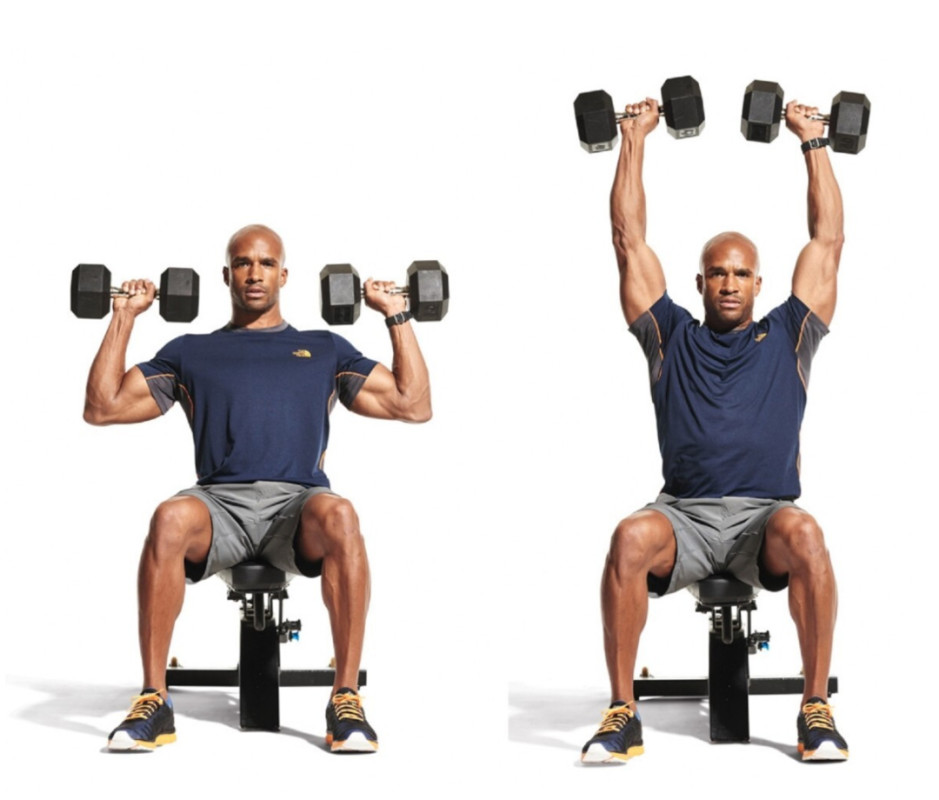 Dumbbell Shoulder Press
Dumbbell Shoulder Press
James Michelfelder
How to Do It
- Start with the dumbbells in both hands, fingers facing forward, just above your shoulders by your ears, to start.
- Soften your knees until they aren’t fully locked and brace your core.
- Take a deep breath in before exhaling as you push the dumbells above your head, together but not touching.
- Resist the weight as you slowly bring them back down.
- That’s 1 rep.
- Repeat for 10 to 15 repetitions.
3. Barbell Bentover Rows  Bent Over Row
Bent Over Row
Beth Bischoff
How to Do It
- Begin by placing a barbell in front of you and grab it with an overhead grip, arms shoulder-width apart, to start.
- Bend your legs slightly and send your hips back until you are hinged at the waist.
- Let the barbell hang in front of your legs slightly without allowing it to touch you.
- Inhale, then exhale as you row the barbell up, pulling your shoulder blades together at the top.
- Slowly lower it back to start.
- That’s 1 rep.
- Repeat the movement for 8 to 10 reps.
Pro Tip
As you move through the exercise, brace your core while keeping your chest high and spine neutral without allowing your shoulders to droop forward.
4. Dumbbell Split Squats 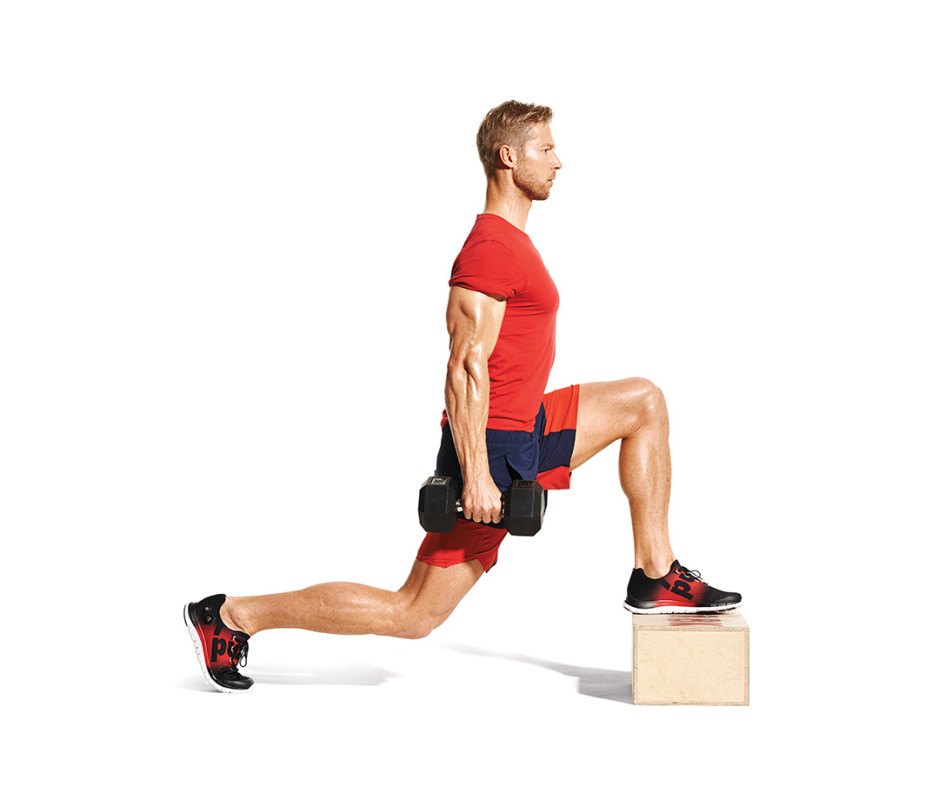 Split Squat
Split Squat
James Michelfelder
How to Do It
- Standing in front of a bench, hold a dumbbell in each hand with your arms fully extended and palms facing one another, to start.
- Place your feet shoulder-width apart and elevate one foot behind you on a bench.
- Keeping a slight forward lean to your front leg, inhale as you bend the front leg until it’s at or close to a 90-degree angle (you may need to move your foot forward or backward).
- Exhale as you push into the front foot to straighten the leg.
- That’s 1 rep.
5. Dumbbell Chest Presses on Swiss Ball 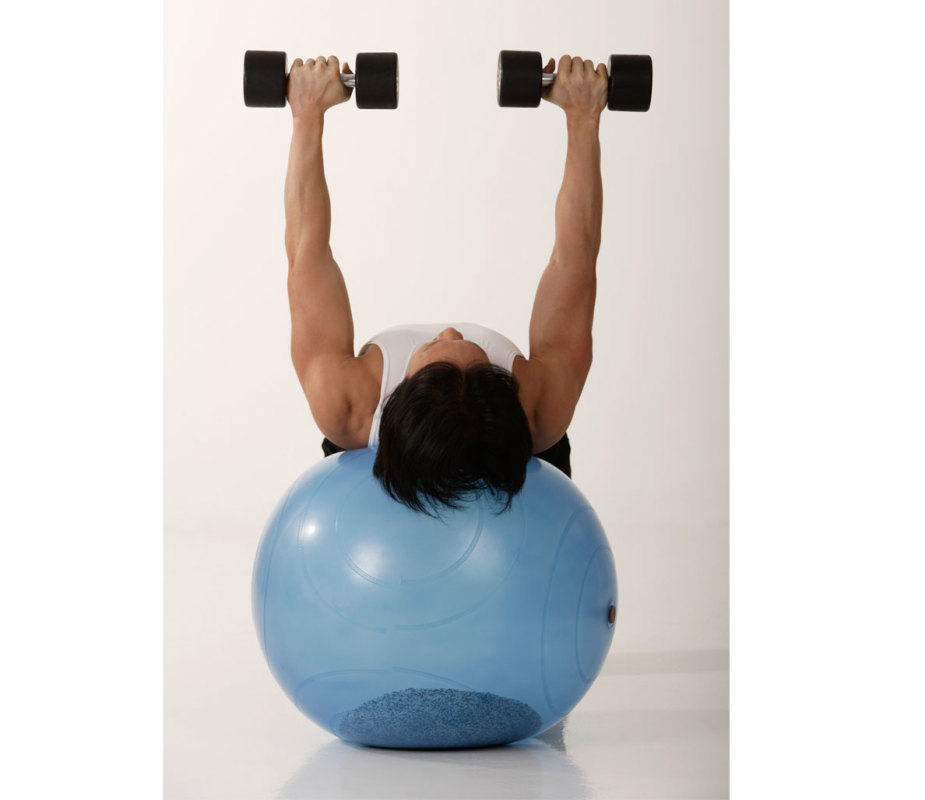 How to Do It
How to Do It
- Sit on a Swiss ball, with a dumbbell in both hands resting on your thighs, to start.
- Slowly walk your body forward until your upper back is resting on the ball and your feet are right under your knees, which are bent at 90-degree angles.
- Shift the dumbbells so they’re in a chest-press position, elbows slightly flared to the sides.
- Without letting your hips sag, inhale, then exhale and press the dumbbells up so your arms are straight above your chest.
- Inhale as you lower the weights back down.
- That’s 1 rep.
- Repeat for 10 to 12 repetitions.
6. Wide-Grip Pullups 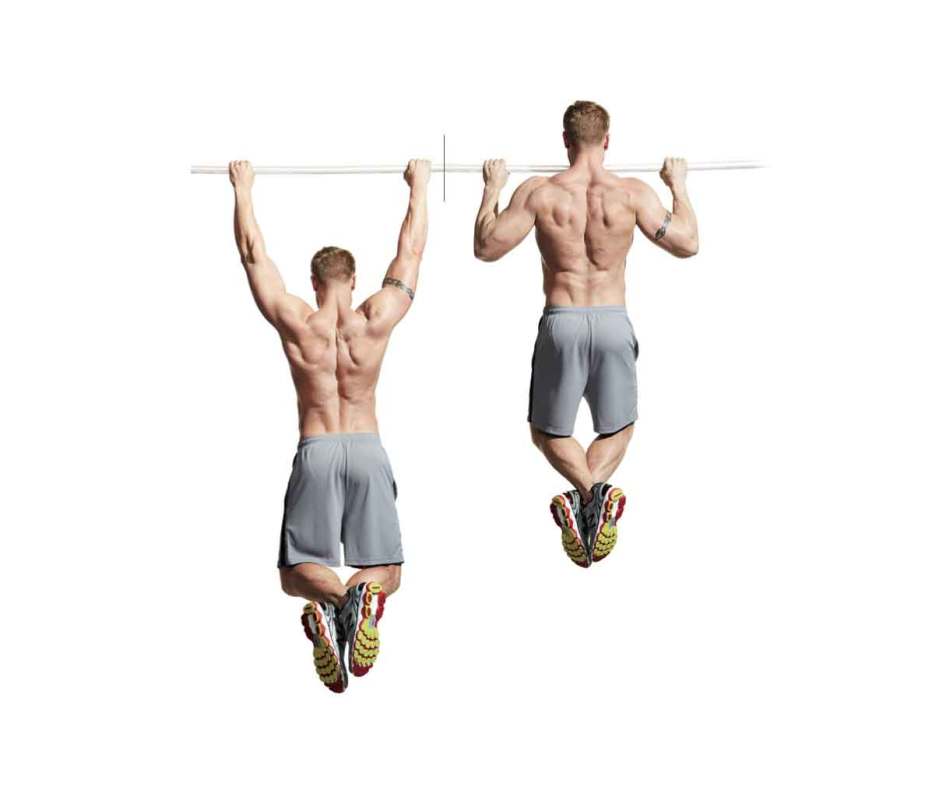 Wide-Grip Pullup
Wide-Grip Pullup
Beth Bischoff
How to Do It
- On a bar or assisted pullup machine, place your hands so they are each 6 to 8 inches beyond your shoulder width, fingers facing away from you, to start.
- Inhale, then exhale as you pull your body up, chin above the bar.
- Inhale as you lower down with control.
- That’s 1 rep.
Pro Tip
If you don’t have an assisted pullup machine you can attach a resistance band to the bar and loop the end around your foot.
7. Dumbbell Stepups 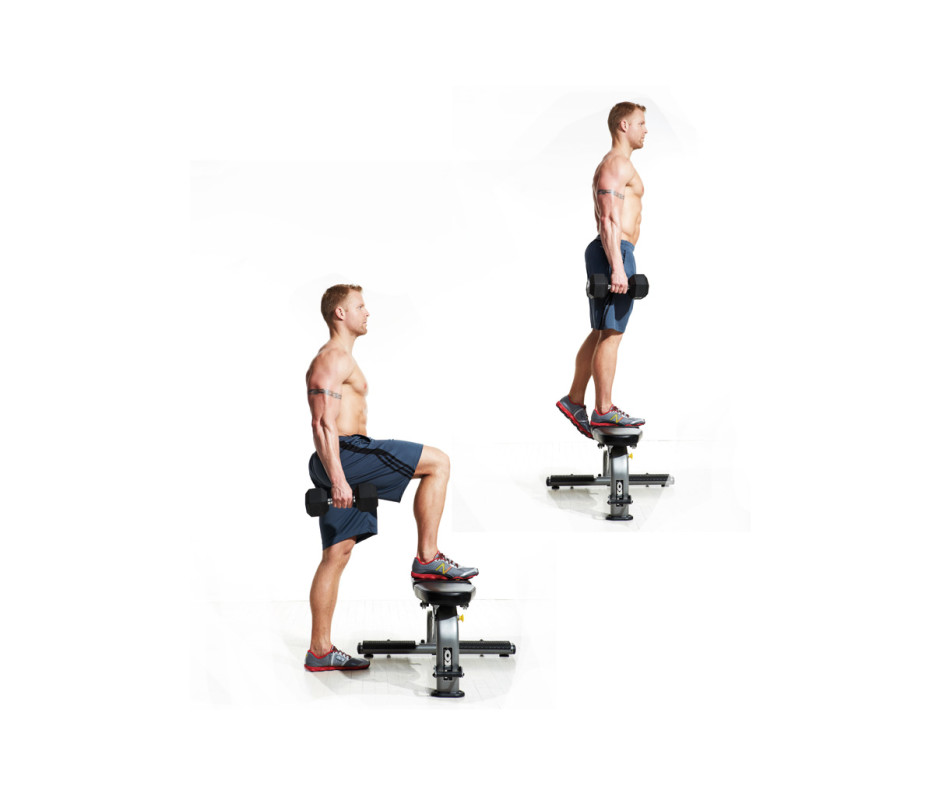 Dumbbell Step-Up
Dumbbell Step-Up
Beth Bischoff
How to Do It
- Hold a dumbbell in each hand at your sides with your palms facing each other, to start.
- Using a box or bench, inhale then exhale as you step up with one foot and follow with the other so you’re standing atop the platform.
- Step back down with the same foot.
- Do it again, leading with the opposite foot.
- That’s 1 rep.
8. Medicine Ball Slams  Medicine Ball Floor Slam
Medicine Ball Floor Slam
Beth Bischoff
How to Do It
- With your feet shoulder-width apart, lift a heavy medicine ball above your head, to start.
- Tighten your core and slightly drive your hips backward.
- Inhale, then using all the force you can muster, slam the ball into the floor in front of you.
- Catch it on the rebound (or pick it up).
- That’s 1 rep.
9. Barbell Hip Thrusts  Barbell Hip Thrust
Barbell Hip Thrust
James Michelfelder
How to Do It
- Sit on the floor with your back perpendicular to a bench and a barbell resting in your hip crease, to start.
- Rest your shoulders against the bench and bend your knees so your feet are on the floor.
- With your hands holding the barbell in place, inhale, then exhale as you press your hips toward the ceiling until your body (from knees to shoulders) forms a flat tabletop position.
- Inhale as you crease your hips to lower your glutes back down.
- That’s 1 rep.
10. Decline Pushups  Decline Pushup
Decline Pushup
James Michelfelder
How to Do It
- Come into a plank position with your feet elevated on a bench and your hands directly under your shoulders, to start.
- Inhale as you lower your chest toward the ground, making sure that your elbows stay tucked back behind you, not flaring to the sides.
- Exhale as you push up.
- That’s 1 rep.
How Long Does it Realistically Take to Get in Shape?
According to Jahkeen Washington, a certified personal trainer and owner of Harlem Kettlebell Club, the amount of time it takes to lose weight varies from person to person and comes down to how often they train, how they train, their nutrition, and their starting point.
“I think that a three-month commitment to exercise two to three times a week is plenty, and that’s where I’ve seen most people really start to buy in and see the results they’re looking for,” says Washington. “For the first month, you tend to learn the how, the what, the why—what exercises work and what doesn’t work. Then by months two and three, you’re able to really start to adjust and hit things pretty hard. By then, someone just got their 30 days in, they’ve got some consistency, and some of that early soreness that they experience is starting to fade away.”
Related: How to Build a Workout Routine That Delivers Big Results
How Many Times a Week Should I Work Out?
A workout routine isn’t as easy as a simple math equation. According to Washington while three days might be the key to fat loss and muscle gain for some people, others might have to squeeze a few more workouts in to see the results they want.
“In a perfect world, someone can train five days a week,” says Washington. “In terms of weight loss, I think it depends on the person and how much weight they’re trying to lose.”
Someone trying to shave off five pounds won’t need to be as aggressive. They] won’t need to work as hard or as frequently as someone who has a lot more to lose or is looking to set a goal and have a timeframe on it. The amount of weight someone wants to lose (and how quickly) will dictate how many times per week they need to work out.


